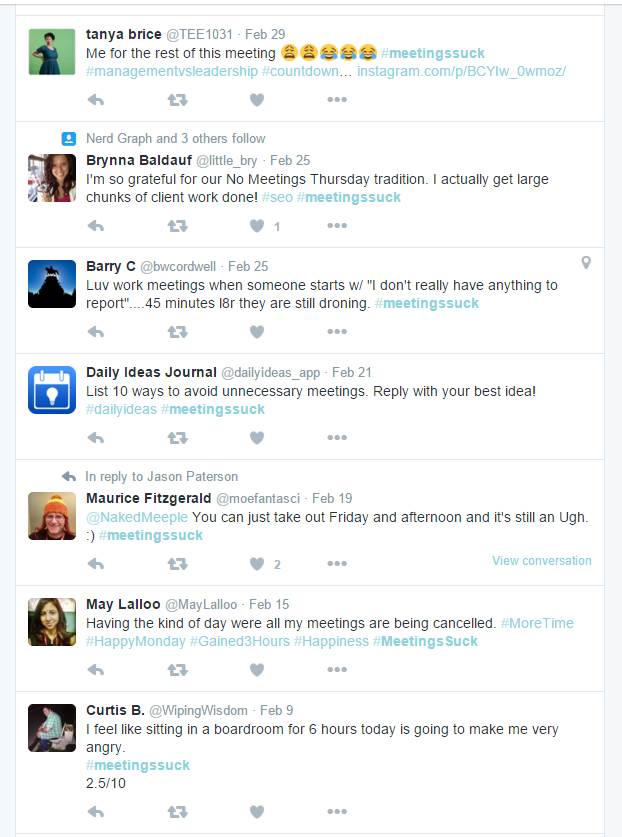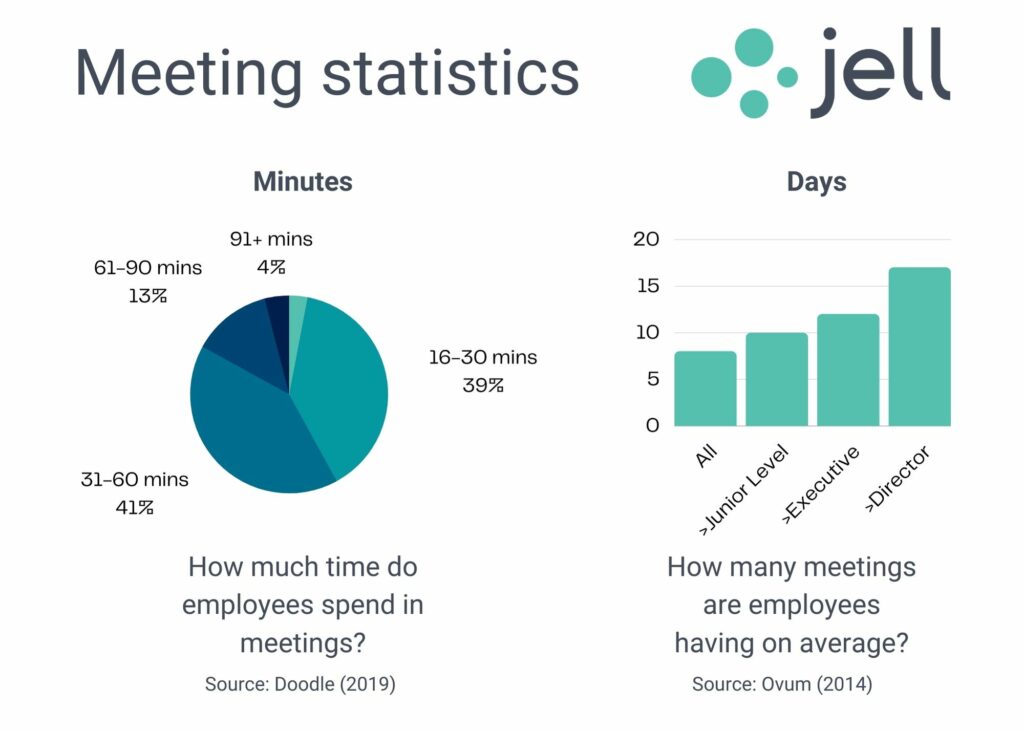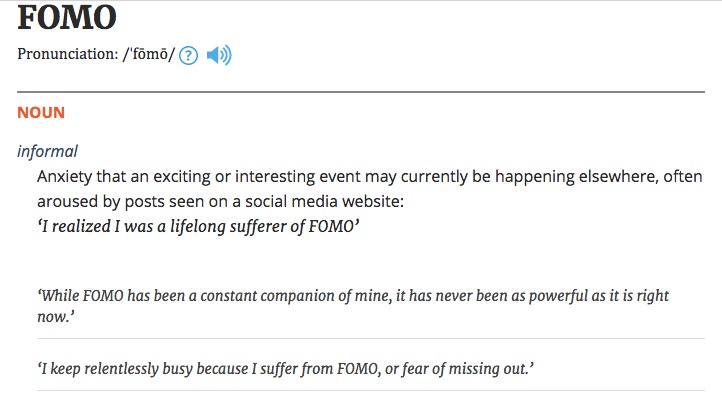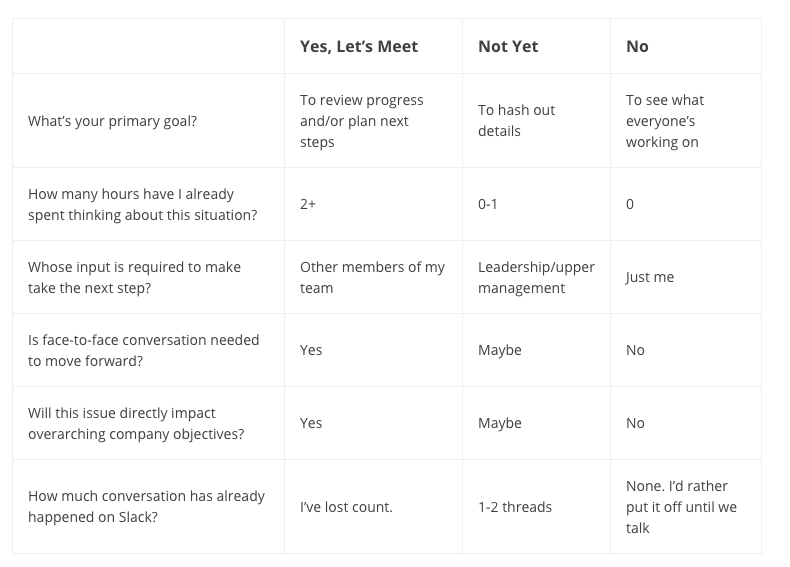 If you view weekly status updates or daily check-ins as a necessary cost of managing a team, this is the post for you. If you regularly multitask or tune out during meetings, this post is for you, too. And if you attend or schedule routine meetings because you’re afraid of missing out on important details, well, keep reading.
If you view weekly status updates or daily check-ins as a necessary cost of managing a team, this is the post for you. If you regularly multitask or tune out during meetings, this post is for you, too. And if you attend or schedule routine meetings because you’re afraid of missing out on important details, well, keep reading. Optimize Your Meetings with Jell
Daily Standups, Check-ins, & OKRs.
14-day free trial. No credit card required.
Related Articles
The Secret to Running Successful Meetings
You Know Your Meetings Suck If…
The Science of Productive Meetings: Quality Over Quantity
There is a psychological explanation for all of this.After decades worth of evidence showing how unproductive routine meetings can be (estimates range from 300,000 hours to $300 million lost to meetings for the average big business), managers seem as addicted to them as ever. Many continue to hold group “think” sessions that lack clear agendas and status meetings with no time limits.
This madness must end.
In some corners of the work world, it has. Thanks to emerging communications technology and the COVID-19 pandemic, many businesses are testing the waters of meeting-free collaboration. As life moved from in the office to at home, communication through Slack and other online meeting channels became ubiquitous. But are all of these Zoom meetings effective? If we know that employees complain about them and attendees fall asleep during them, why do so many managers still feel a need to schedule recurring, routine meetings? How have weekly statuses and daily stand-ups become so ingrained that we’re resistant to removing them from calendars and replacing them with other forms of modern-day communication?The answers lie in social science.So, what are routine meetings?
Routine meetings are scheduled discussion and group planning sessions. They’re typically not impromptu and are usually informal. They can occur at any time interval and maybe monthly progress reports, discussions, project reviews, one-on-ones, annual reviews, or comprehensive updates. In order to be productive, they must be organized and follow an agenda. Whether you hold weekly team meetings, daily stand-ups, or sprint reviews, all exhibit formatting patterns. A meeting consists of two parts:- Information Sharing: updates, announcements, shout-outs, sharing project progress
- Collaboration: decision making, resolving blockers, outlining goals
How much time do routine meetings take up?
 According to statistics from Doodle, Ovum, AskCody, ReadyTalk, Atlassian, National Bureau Of Economic Research, and WSJ, since 2000, the time spent in meetings has risen by 8-10% annually. This is possibly caused by a variety of reasons like a shift in work culture. Companies are increasingly less hierarchical and employees are increasingly self-directed. Employees’ voices are being heard and meetings are the perfect medium. Another reason is the COVID-19 pandemic that changed the landscape of meetings, transitioning once mundane in-person meetings to online meetings where you could log in to Zoom, turn your camera off, and make pancakes in the process all while petting your dog. In 2020, the number of meetings attended by a worker rose by 13.5%. However, researchers found a 20.1% decrease in the average length of meetings. Researchers also found the average meeting count rose from 5.9 meetings (from before the pandemic) to 6.9 meetings. Other interesting facts:
According to statistics from Doodle, Ovum, AskCody, ReadyTalk, Atlassian, National Bureau Of Economic Research, and WSJ, since 2000, the time spent in meetings has risen by 8-10% annually. This is possibly caused by a variety of reasons like a shift in work culture. Companies are increasingly less hierarchical and employees are increasingly self-directed. Employees’ voices are being heard and meetings are the perfect medium. Another reason is the COVID-19 pandemic that changed the landscape of meetings, transitioning once mundane in-person meetings to online meetings where you could log in to Zoom, turn your camera off, and make pancakes in the process all while petting your dog. In 2020, the number of meetings attended by a worker rose by 13.5%. However, researchers found a 20.1% decrease in the average length of meetings. Researchers also found the average meeting count rose from 5.9 meetings (from before the pandemic) to 6.9 meetings. Other interesting facts:- 36% of a meeting’s duration was around 30 minutes, while only 20% of meetings lasted for an hour.
- For 31% of all meetings held, the second most common meeting length was 15 minutes.
- 44% of the group meetings in 2020 were limited to 4 to 7 people while 25% of the meetings held fewer participants ranging from 4 to 5.
 But meetings don’t only impact employee satisfaction, they come at another cost.71% of employees waste time every week due to unproductive, routine meetings, and 31 hours are spent on unnecessary routine meetings monthly. And it doesn’t stop there. There’s also a time cost to prepare for meetings.40% of workers waste up to 30 minutes searching for a collaborative meeting space while the average employee spends an hour and 9 minutes preparing for each meeting. I remember my first professional job. I was excited to get the job done except that 50% of the week I was in meetings. I spent at least:
But meetings don’t only impact employee satisfaction, they come at another cost.71% of employees waste time every week due to unproductive, routine meetings, and 31 hours are spent on unnecessary routine meetings monthly. And it doesn’t stop there. There’s also a time cost to prepare for meetings.40% of workers waste up to 30 minutes searching for a collaborative meeting space while the average employee spends an hour and 9 minutes preparing for each meeting. I remember my first professional job. I was excited to get the job done except that 50% of the week I was in meetings. I spent at least:- 1.25 hours in stand-up meetings
- 2 hours in departmental meetings
- 3 hours in weekly one-on-one meetings with 2 different managers
- Daily stand-ups (1.5-2.5 hours/week)
- Sprint planning (2 hours every sprint period)
- Sprint review (2 hours every sprint period)
- Sprint retrospective (2 hours every sprint)
- Department meetings (1-2 hours every week)
- One-on-one meetings (1-2 hours every week)
- Company all-hands meetings (1-2 hours, once or twice a month)
- Keep close tabs on what members of your team are working on.
- When work is mundane for that week, but a meeting is scheduled, managers feel an obligation to fill the time with the meeting regardless of its necessity.
- Emergency meetings solve a problem, but routine meetings can sometimes add to the problems–making problems where none exist.
The Psychology of Routine Meetings
 In 2013, a new word was added to the Oxford English Dictionary: FOMO. It stands for “fear of missing out” and is defined as “anxiety that an exciting or interesting event may currently be happening elsewhere.”
In 2013, a new word was added to the Oxford English Dictionary: FOMO. It stands for “fear of missing out” and is defined as “anxiety that an exciting or interesting event may currently be happening elsewhere.” This deep-seated feeling of apprehension has become so prevalent in the 20th century workplace that it drives, often unconsciously, how we approach important managerial decisions related to delegation, communication and meetings.For instance, the manager who doesn’t see his team grouped together on a weekly basis may worry that he won’t know what everyone’s working on. Likewise, the team leader who asks to be cc’d on every email fears becoming out of touch with employees.Personalities also play a role. Countless surveys have indicated that people who fall on the introverted end of the Myers-Briggs spectrum thrive on solitude and need time to reflect. Extroverts, in contrast, are drawn to group brainstorming sessions and team activities. They are more inclined to schedule meetings for the perceived benefits of face-to-face communication rather than out of a necessity to actually meet.In actuality, both of these meeting motivators—FOMO and an innate need for in-person interactions—can overwhelm and make us less productive. This is especially true of the group brainstorm, which has been shown by decades to hinder teams from achieving goals. Organizational psychologist Adrian Furnham put it this way:“The evidence from science suggests that business people must be insane to use brainstorming groups. If you have talented and motivated people, they should be encouraged to work alone when creativity or efficiency is the highest priority.”And in REBOOT, minimalist Shauna Mackenzie says this:“Participants in brainstorming sessions usually believe that the group performed much better than it did. They do one thing–make people feel attached—but that’s about the only goal achieved in a group brainstorm.”Perhaps one of the most dangerous psychological influences of all is the erroneous belief that the mere act of coming together as a group leads to accomplishment—even when no goals are set or met.“Meetings have become a popular form of communication because many leaders feel that iterative interaction with their team members creates a more efficient workplace,” communications efficiency consultant Zach Schaefer told Jell. “One manager once told me that ‘If my team members see me on a weekly basis, I can better motivate them and hold them accountable.’ Holding people accountable should have less to do with where you deliver that message and more to do with how you are delivering it.”Instead, take a good hard look at the recurring meetings on your calendar. How many of them have outlived their purpose? Which ones could be handled more efficiently in a Slack channel or online standup? Which do you really need?If you are struggling to answer these questions, I highly recommend consulting this chart to help make the decision faster:
This deep-seated feeling of apprehension has become so prevalent in the 20th century workplace that it drives, often unconsciously, how we approach important managerial decisions related to delegation, communication and meetings.For instance, the manager who doesn’t see his team grouped together on a weekly basis may worry that he won’t know what everyone’s working on. Likewise, the team leader who asks to be cc’d on every email fears becoming out of touch with employees.Personalities also play a role. Countless surveys have indicated that people who fall on the introverted end of the Myers-Briggs spectrum thrive on solitude and need time to reflect. Extroverts, in contrast, are drawn to group brainstorming sessions and team activities. They are more inclined to schedule meetings for the perceived benefits of face-to-face communication rather than out of a necessity to actually meet.In actuality, both of these meeting motivators—FOMO and an innate need for in-person interactions—can overwhelm and make us less productive. This is especially true of the group brainstorm, which has been shown by decades to hinder teams from achieving goals. Organizational psychologist Adrian Furnham put it this way:“The evidence from science suggests that business people must be insane to use brainstorming groups. If you have talented and motivated people, they should be encouraged to work alone when creativity or efficiency is the highest priority.”And in REBOOT, minimalist Shauna Mackenzie says this:“Participants in brainstorming sessions usually believe that the group performed much better than it did. They do one thing–make people feel attached—but that’s about the only goal achieved in a group brainstorm.”Perhaps one of the most dangerous psychological influences of all is the erroneous belief that the mere act of coming together as a group leads to accomplishment—even when no goals are set or met.“Meetings have become a popular form of communication because many leaders feel that iterative interaction with their team members creates a more efficient workplace,” communications efficiency consultant Zach Schaefer told Jell. “One manager once told me that ‘If my team members see me on a weekly basis, I can better motivate them and hold them accountable.’ Holding people accountable should have less to do with where you deliver that message and more to do with how you are delivering it.”Instead, take a good hard look at the recurring meetings on your calendar. How many of them have outlived their purpose? Which ones could be handled more efficiently in a Slack channel or online standup? Which do you really need?If you are struggling to answer these questions, I highly recommend consulting this chart to help make the decision faster:
Experiments in Meeting Obliteration
What if you discover that the majority of your recurring meetings are in fact unnecessary? Is it possible to eliminate them altogether? And still be productive?Well, yes. There’s already a growing revolt, particularly in the tech world, among team leaders who have determined the recurring meeting is long overdue for an overthrow. Several companies are proving that it is in fact possible to achieve more by meeting less.For example…In 2013, Dropbox initiated Armeetingeddon.
Every single recurring meeting at the company was deleted from company calendars. Executives gave employees two weeks to thoughtfully consider each meeting before returning it to their calendars—and deleted any that resurfaced during the interim period.How did it turn out? Here’s what Inc. reported two years later:Dropbox employs nearly three times as many people at its San Francisco headquarters, yet it has only approximately doubled the number of conference rooms. Until recently, the number of recurring meetings has not increased despite the company’s growth. In the post-Armeetingeddon era, meetings are shorter and more productive, with less rambling discussion and more focus on making decisions.In 2015, Slack cancelled all recurring meetings.
Company executives instructed team leaders to take some meeting-free time to determine how many of the recurring ones were really necessary. CEO Stewart Butterfield described the decision this way:“Everyone should try to make the lives of everyone else who works here a little bit simpler. So if you’re going to call a meeting, you’re responsible for it, and you have to be clear what you want out of it.”At Asana, meetings are banned every Wednesday.
According to Asana’s No Meeting Wednesday policy, it’s against company rules to schedule internal meetings midweek. A meeting must be absolutely necessary to circumvent this rule. The goal is to give managers and team members more disruption-free time to focus on work with at least one day every week that isn’t schedule driven.We asked if meetings tend to pile up the rest of the week as a result. Here’s what the company’s communications team had to say:“Overall, the average experience is not a pile up of other meetings since generally Asana aims to approach the whole shebang of meetings quite productively and mindfully.”The keyword here is “mindfully.” When driven by a desire to achieve, instead of a psychological need to meet, thoughtful meetings have the power to unite teams and help companies reach important goals faster.Jell helps you reach important goals faster. Just set your goals, share the details of your progress with your team, and quantify your performance to analyze what went well and what didn’t.Decades of research have conclusively determined that routine meetings are inefficient. Many managers and employees still hold onto them, perpetuating the cycle of unproductivity. Overcoming the drill of mindless meetings requires overcoming psychological fears of missing out on important information and opportunities to bond. Experiments in meeting elimination have shown how skipping the routine ones can make teams happier and more productive. So, how are you going to change your next routine meeting?Reach Important Goals Faster
